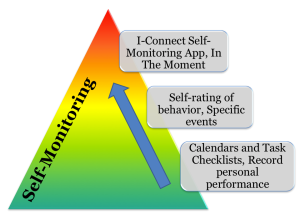 ASD On The Go uses a continuum of intensity of self-monitoring as a key component of intervention for individuals with autism. Self-monitoring is a type of intervention that involves individuals regulating and assessing their own performance and behavior. With self-monitoring, individuals learn to discriminate between appropriate/inappropriate behaviors and monitor themselves. Self-monitoring for individuals with autism spectrum disorder (ASD) aims to increase independence rather than relying on another individual to keep them on task (e.g., teacher, therapist, parent, service provider). Self-monitoring is considered an evidence-based practice for individuals with ASD ages 3-22 (Wong et al., 2015). With ASD On The Go, Self-monitoring can decrease prompt dependency and increase engagement in target skills.
ASD On The Go uses a continuum of intensity of self-monitoring as a key component of intervention for individuals with autism. Self-monitoring is a type of intervention that involves individuals regulating and assessing their own performance and behavior. With self-monitoring, individuals learn to discriminate between appropriate/inappropriate behaviors and monitor themselves. Self-monitoring for individuals with autism spectrum disorder (ASD) aims to increase independence rather than relying on another individual to keep them on task (e.g., teacher, therapist, parent, service provider). Self-monitoring is considered an evidence-based practice for individuals with ASD ages 3-22 (Wong et al., 2015). With ASD On The Go, Self-monitoring can decrease prompt dependency and increase engagement in target skills.
Below are several examples of studies that examine the effectiveness of self-monitoring:
- Bouck, E. C., Savage, M., Meyer, N. K., Taber-Doughty, T., & Hunley, M. (2014). High-tech or low-tech? Comparing self-monitoring systems to increase task independence for students with autism. Focus on Autism and Other Developmental Disabilities, 29, 156-167.
- Three students with autism utilized low-tech self-monitoring (paper/pencil) and high-tech self-monitoring (iPad) to cook recipes with multiple steps. Both low-tech and high-tech self-monitoring procedures were effective but participants reported a preference for high-tech.
- Cihak, D. F., Wright, R., & Ayres, K. M. (2010). Use of self-modeling static-picture prompts via a handheld computer to facilitate self-monitoring in the general education classroom. Education and Training in Autism and Developmental Disabilities, 45, 136-149.
- Self-monitoring and picture prompts were used with three middle school students with ASD to increase academic engagement in general education classrooms. The students’ on-task engagement increased while teachers’ verbal prompts decreased. Both special and general education teachers rated the self-monitoring intervention as effective and appropriate.
- Crutchfield, S. A., Mason, R. A., Chambers, A., Wills, H. P., & Mason, B. A. (2015). Use of a self-monitoring application to reduce stereotypic behavior in adolescents with autism: A preliminary investigation of I-Connect. Journal of Autism and Developmental Disorders, 45, 1146-1155.
- A technology-delivered self-monitoring intervention was used to decrease stereotypic behavior in two middle school students with autism. Results indicated the students decreased their stereotypy and teachers reported they were likely to use the intervention again in the future.
- Kamps, D., Conklin, C., & Wills, H. (2015). Use of self-management with the CW-FIT group contingency program. Education and Treatment of Children, 38, 1-32.
- A self-management intervention was added to a group contingency program for individual at-risk students. Selected students scored themselves on their classroom behavior consistent of the school-wide behavior program. The self-management intervention improved the on-task behavior and decreased the disruptive behavior of the at-risk students.
- Parker, D., & Kamps, D. (2011). Effects of task analysis and self-monitoring for children with autism in multiple social settings. Focus on Autism and Other Developmental Disabilities, 26, 131-142.
- Task analyses with self-monitoring was used to teach daily living skills and increased social interactions with two students with ASD in social settings with typically developing peers.
- Rosenbloom, R., Mason, R. A., Wills, H. P., & Mason, B. A. (2016). Technology delivered self-monitoring application to promote successful inclusion of an elementary student with autism. Assistive Technology, 28, 9-16.
- A self-monitoring application called I-Connect was used to increase the on-task behavior and decrease disruptive behavior for an elementary student with autism in a general education classroom.
